Michelle Nelson-Schmidt's Blog, page 3
November 26, 2025
The Rational Reconstruction of Fairy Tales
A rational reconstruction of fairy tales involves analyzing their characters, plot structures, and moral themes to uncover the cultural values and societal norms they reflect and transmit. You can see how these stories serve as vessels for moral guidance, emphasizing virtues like honesty or bravery, while also revealing community beliefs and shared ideals. By examining their origins and how they adapt across cultures, you’ll gain deeper insight into what these stories reveal about societal priorities—if you look closer, you’ll discover more.
Key TakeawaysRational reconstruction analyzes fairy tales to uncover underlying moral principles and societal values they convey.It involves systematically interpreting stories to understand their cultural and ethical significance.This approach examines character choices and narrative structures to reveal moral lessons and societal norms.Rational reconstruction highlights how fairy tales reflect and reinforce cultural identities and collective beliefs.It transforms stories into logical frameworks for understanding their role in moral education and cultural transmission.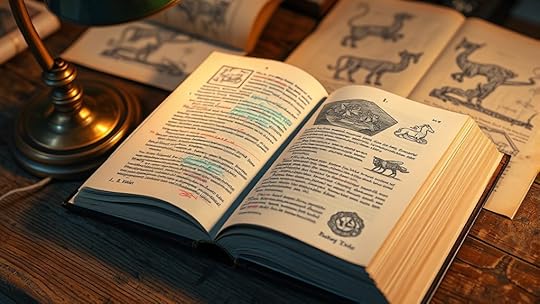
Fairy tales have captivated audiences for generations, but beneath their enchanting stories lie themes and elements that can be understood through rational analysis. At their core, many fairy tales serve as vessels for moral lessons, subtly guiding listeners toward societal values and personal virtues. These stories often showcase characters facing challenges or making choices that highlight the importance of honesty, kindness, bravery, and perseverance. When you look beyond the surface, you realize that these tales are designed to teach important life lessons in a way that’s memorable and engaging. They reflect the moral priorities of the cultures that created them, revealing what societies value most. For example, stories emphasizing the virtue of honesty or the dangers of greed mirror the moral standards upheld by the community. By analyzing these lessons, you see how fairy tales function as cultural mirrors, transmitting shared beliefs across generations.
Cultural influences play a significant role in shaping fairy tales’ themes and motifs. You can think of these stories as cultural artifacts, each carrying the imprint of the society’s history, beliefs, and social norms. For instance, tales originating from different regions often feature distinct characters, settings, and morals that mirror local customs and values. When you examine fairy tales from various cultures, you notice how they reflect unique societal concerns—whether it’s the importance of family loyalty, social hierarchy, or spiritual beliefs. These stories act as a window into the collective psyche of a community, illustrating what it considers important and how it perceives morality. *Furthermore*, cultural influences often influence the narrative structure itself, shaping how stories are told and what themes resonate most deeply. Recognizing these cultural underpinnings allows you to appreciate fairy tales not just as entertaining stories but as profound expressions of collective identity. Additionally, understanding toilet flushing mechanisms and efficiency can provide useful insights into modern plumbing technologies that have evolved to meet environmental and practical needs.
Frequently Asked QuestionsHow Does Rational Reconstruction Differ From Traditional Fairy Tale Analysis?Rational reconstruction differs from traditional fairy tale analysis by focusing on symbolic analysis and the narrative structure. You examine how symbols convey deeper meanings and how the story’s design supports its message. Unlike traditional methods, which often emphasize moral lessons or cultural context, rational reconstruction seeks logical coherence, revealing the underlying mechanisms that shape the tale’s message. This approach helps you understand fairy tales in a more systematic, analytical way.
What Are the Main Benefits of Applying Rational Reconstruction to Fairy Tales?Imagine you analyze Cinderella through rational reconstruction, uncovering how its symbolic interpretation reveals societal values. Applying this method helps you critique cultural norms embedded in fairy tales, offering deeper insights. The main benefits include understanding underlying messages, highlighting cultural critique, and revealing how stories reflect societal changes. This approach enables you to see beyond surface narratives, fostering a more nuanced appreciation of fairy tales’ roles in shaping and mirroring cultural identities.
Can Rational Reconstruction Be Used to Interpret Modern Stories?Yes, you can definitely use rational reconstruction to interpret modern stories. By applying symbolic analysis, you uncover deeper meanings behind characters and themes, just like with fairy tales. Recognizing character archetypes helps you see patterns and understand motivations. This approach allows you to analyze contemporary narratives critically, revealing how they reflect cultural values and human psychology, making your interpretation richer and more insightful.
Are There Cultural Biases in the Rational Reconstruction Process?Yes, cultural biases can influence the rational reconstruction process. You might notice that your cultural perspectives shape how you interpret stories, which can lead to bias acknowledgment being overlooked or underestimated. This process often reflects the dominant cultural narratives, making it necessary for you to actively question your assumptions. Recognizing these biases helps guarantee a more balanced interpretation, allowing you to appreciate diverse cultural perspectives and avoid skewed reconstructions.
How Does Rational Reconstruction Impact the Understanding of Fairy Tale Morals?You might find that rational reconstruction clarifies fairy tale morals by stripping away cultural biases, revealing universal themes like honesty and bravery. However, it can also obscure the cultural context that shaped these morals, risking oversimplification. This process impacts your understanding by emphasizing moral clarity, but be aware it might overlook the nuanced ways different cultures interpret these stories, limiting their full cultural significance.
ConclusionBy understanding the rational roots behind fairy tales, you see how they reflect universal truths and human experiences. Isn’t it fascinating how these stories, often dismissed as simple fantasies, actually reveal deep insights into our psychology and culture? So next time you hear a fairy tale, remember it’s more than just entertainment—it’s a window into human nature. Wouldn’t you agree that exploring these stories helps you understand yourself and others better?
Napoleon’S Yeti Encounter in the Alps: Separating Myth From Memoir
There’s no solid evidence that Napoleon Bonaparte ever encountered a Yeti in the Alps, but stories link him to mountain mysteries, blending fact and folklore. These tales often stem from 19th-century exploration fantasies and the allure of the unknown, fueling myths that persist today. While eyewitness accounts and photos are inconclusive, understanding how legends evolve helps distinguish reality from imagination. If you want to uncover more about this intriguing myth, keep exploring the fascinating history behind it.
Key TakeawaysThere is no credible historical evidence linking Napoleon Bonaparte to a Yeti encounter in the Alps.The Yeti legend originates from Alpine folklore, long before Napoleon’s era, blending myth and cultural symbolism.Reports of mysterious footprints and sightings in the Alps are often misinterpreted or fabricated, lacking scientific verification.Napoleon’s historical records do not mention any encounters with cryptids or mythical creatures like the Yeti.The myth of Napoleon’s Yeti encounter is likely a modern legend or fictional storytelling rather than a documented event.The Origins of the Yeti Legend in Alpine Folklore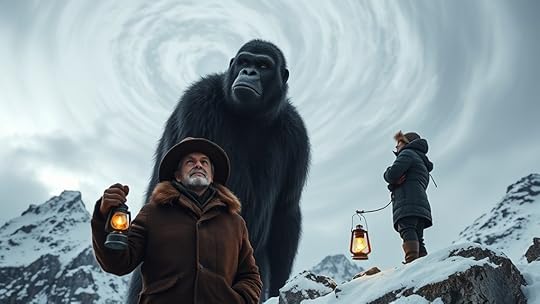
The legend of the yeti has roots deep in Alpine folklore, where local communities have long spoken of a mysterious, primate-like creature lurking in the mountains. This creature symbolizes more than just mystery; it embodies mountain spirituality, representing the wild, untamed essence of the highlands. As you explore the Alps, you’ll notice how the rugged landscape, dotted with alpine flora, fuels stories of the yeti’s presence. The diverse plants and vibrant ecosystems seem to whisper ancient tales, reinforcing the idea that these mountains are sacred ground. Over generations, these stories have intertwined with spiritual beliefs, portraying the yeti as a guardian of the mountain’s secrets. This blend of myth and reverence continues to shape the legend, emphasizing nature’s spiritual significance in alpine culture.
Napoleon’s Expeditions in the Snowy Mountains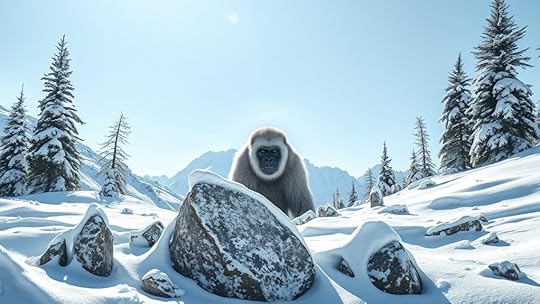
During his campaigns through the snowy mountains, Napoleon demonstrated remarkable resilience and strategic ingenuity as he navigated treacherous terrain and unpredictable weather. You notice how the mountain geology shaped his path, with jagged rocks and hidden crevasses demanding careful planning. The alpine flora, sparse yet resilient, clings to rocky slopes, hinting at the harsh conditions faced by explorers. Napoleon’s teams relied on their understanding of these natural features to avoid avalanches and find safe routes. His expeditions pushed through snowdrifts and icy ridges, showcasing his ability to adapt to the rugged landscape. Each step tested his leadership and resourcefulness, proving that even in the most challenging environments, strategic thinking and knowledge of mountain geology and alpine flora could turn obstacles into opportunities.
The First Reported Sightings and Eyewitness Accounts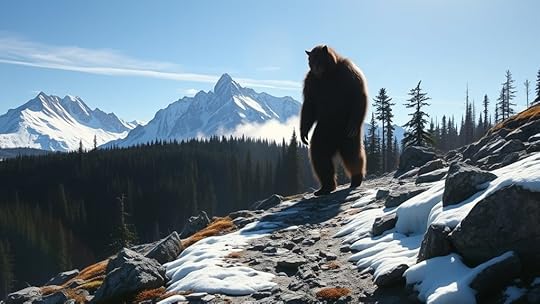
As curious observers began to report strange sightings in the snowy wilderness, accounts of an elusive, towering creature surfaced unexpectedly. Early eyewitnesses described unusual Yeti footprints, often larger than human tracks, igniting speculation rooted in Alpine myths. These reports varied, but common elements emerged:
Sightings of a large, ape-like figure moving swiftly through the snow.Footprints that appeared inconsistent with known animal tracks.Sightings often at dawn or dusk, adding to their mysterious aura.Testimonies from hunters and mountaineers who claimed encounters.Eyewitnesses report large Yeti footprints and elusive sightings fueling Alpine legends and mystery.
These accounts fueled legends and attracted explorers enthusiastic to verify the stories. The consistency of footprints and eyewitness descriptions kept the Yeti myth alive, blurring lines between fact and folklore in the Alpine region.
Analyzing the Physical Evidence and Photographs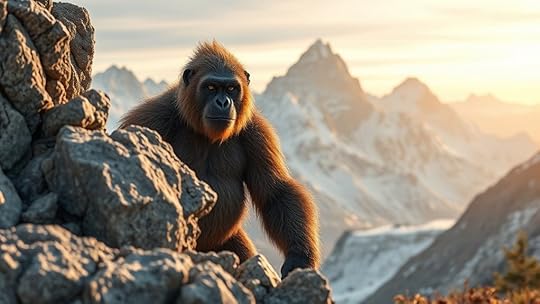
When examining the photographs and physical evidence, you’ll find that authenticity is often difficult to confirm. Many images show inconsistencies or signs of manipulation, raising questions about their credibility. Carefully analyzing these pieces can help determine whether they support the existence of the Yeti or are simply hoaxes.
Photographic Authenticity ChallengesPhotographic evidence related to Napoleon’s Yeti encounter faces significant challenges in establishing authenticity, as modern forgeries and distortions can easily deceive the untrained eye. With the proliferation of digital editing tools, it’s easy to create images that seem convincing but are fabricated. When analyzing these photos, consider these points:
Examine the lighting and shadows for consistency.Check for signs of digital manipulation or pixel anomalies.Compare images with known folklore evolution of cryptid sightings.Verify the provenance and metadata to trace origin.These challenges highlight how photographic evidence alone often fails to confirm the existence of cryptids like the Yeti. Instead, such images tend to reflect folklore evolution, blending myth with perceived reality, making it difficult to separate fact from fiction in the visual record.
Physical Evidence ExaminationAnalyzing physical evidence and photographs requires a careful, detailed approach to determine their credibility. When examining cryptid sightings like Napoleon’s Yeti encounter, look for consistency and context in the evidence. Consider the folklore origins that might influence interpretations—are these accounts shaped by local legends or sensational stories? Scrutinize photographs for signs of manipulation, such as unrealistic shadows or distortions. Physical evidence like footprints, hair samples, or unusual markings should be evaluated scientifically, comparing them to known species and geological conditions. Remember, folklore often blurs the line between myth and reality. By applying rigorous analysis, you can better assess whether the evidence supports a genuine cryptid sighting or is rooted in folklore origins, helping to separate myth from memoir.
Cultural Influences and Myth-Making in the 19th Century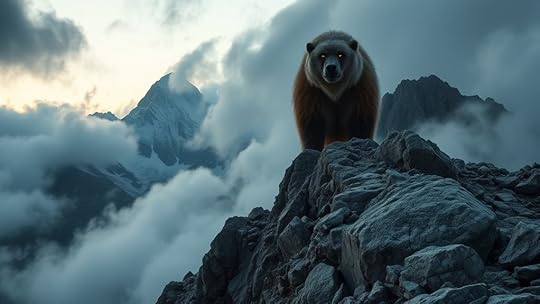
In the 19th century, romanticism’s love for wilderness fueled myths and stories that captured the imagination. You’ll see how national identity builders used these legends to shape cultural pride and unity. At the same time, folklore and scientific curiosity intertwined, fueling fascination with mysterious creatures like the yeti.
Romanticism’s Wilderness ImageryDuring the 19th century, Romanticism transformed wilderness from a mere backdrop into a powerful symbol of the sublime and the unknown, inspiring both artists and writers to explore humanity’s relationship with nature. Your focus on romantic imagery and wilderness symbolism captures this shift, emphasizing the mysterious and awe-inspiring qualities of nature. This movement encouraged you to see the wilderness not just as scenery, but as a reflection of inner emotions and spiritual truths. Consider these key ideas:
Wilderness as a symbol of the sublime, evoking awe and fear.Nature’s role in inspiring introspection and emotional depth.Myth-making through romantic imagery, blending reality and legend.The elevation of wild landscapes as sites of mystical significance.National Identity ConstructionIn the 19th century, nations actively crafted their identities through cultural symbolism and myth dissemination to foster shared pride and unity. You see, governments and intellectuals promoted symbols like national heroes, landmarks, and folklore to create a collective sense of belonging. Myth-making played a key role, as stories and legends were circulated to emphasize unique national traits and virtues. These myths helped shape a common narrative, reinforcing cultural values and historical continuity. By emphasizing certain symbols and stories, nations could inspire patriotism and distinguish themselves from others. As a result, cultural symbolism and myth dissemination became powerful tools in constructing national identities, transforming abstract ideals into tangible symbols that citizens could rally around and celebrate.
Folklore and Scientific CuriosityAs nations shaped their identities through symbols and stories in the 19th century, they also fostered a fascination with the unknown—blending folklore with emerging scientific curiosity. This era saw cryptid folklore and mountaineering myths intertwine, fueling debates about unexplained sightings. You’ll notice that:
Folklore often inspired scientific inquiry, prompting explorers to seek tangible evidence of mythical creatures.Mountaineering myths grew from tales of mysterious beings lurking in remote regions.Enthusiasts debated whether cryptid sightings were genuine or hallucinations fueled by folklore.Cultural influences shaped how societies interpreted strange phenomena, blending myth-making with scientific curiosity.This blend of myth and science created a dynamic curiosity, encouraging exploration while reinforcing cultural narratives of the mysterious Alps.
Comparing the Yeti Tale to Other Mountain Cryptids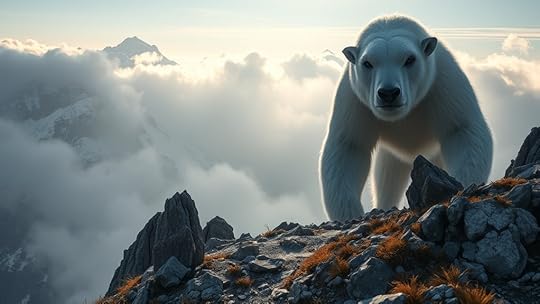
While the Yeti remains one of the most famous mountain cryptids, it shares many similarities and intriguing differences with other legendary creatures lurking in remote ranges worldwide. Like mountain spirits in folklore, many cryptids symbolize nature’s mystery and power, representing the unknown that humans fear or revere. For example, the Bigfoot of North America resembles the Yeti in size and habitat, but often symbolizes primal wilderness and ancestral spirits. The Himalayan Yeti embodies folklore symbolism linked to spiritual guardianship, while the Sasquatch reflects themes of mystery and survival. These creatures often serve as cultural symbols, embodying local legends and collective fears. Comparing these cryptids reveals common threads of myth-making rooted in remote, inaccessible terrains where human understanding is limited.
Modern Investigations and Scientific Perspectives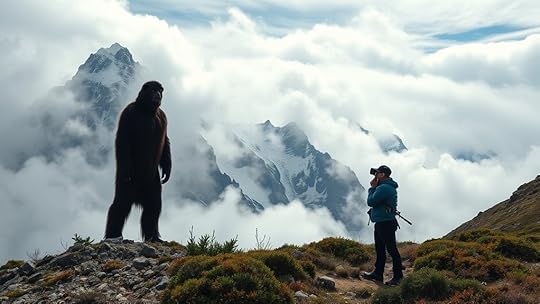
Modern investigations into the Yeti and other cryptids combine scientific rigor with adventurous exploration, often fueled by technological advances. These efforts aim to verify cryptid sightings and distinguish fact from folklore origins. Your focus should be on:
Using camera traps and drones to capture elusive evidence.Analyzing footprints and hair samples with DNA testing.Reviewing historical reports to identify patterns or misidentifications.Applying ecological studies to assess habitat suitability for cryptids.These methods help you separate myth from reality, revealing whether cryptid sightings are based on genuine encounters or folklore origins. While some evidence remains inconclusive, scientific approaches provide a clearer understanding of these mysterious creatures, fueling ongoing curiosity and research.
How Stories Evolve: From Memoir to Myth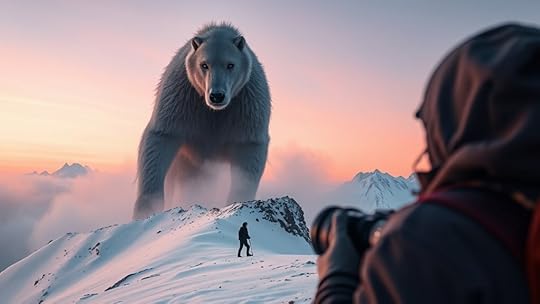
Stories often start as personal memories or eyewitness accounts, but over time, they can transform into myths that shape cultures and beliefs. The Yeti origins, for example, begin in Alpine folklore, where early stories described a mysterious creature lurking in the mountains. As these tales spread, they grew richer, blending eyewitness reports with imagination and local legend. Over generations, the Yeti evolved from a simple cryptid into a symbol of the unknown, embodying fears and mysteries of the high Alps. This evolution demonstrates how stories adapt, gaining significance beyond their initial context. What starts as personal experience often becomes a shared cultural myth, influencing perceptions and legends, and capturing the collective imagination of communities living near the mountains.
Distinguishing Fact From Fiction in Alpine Legends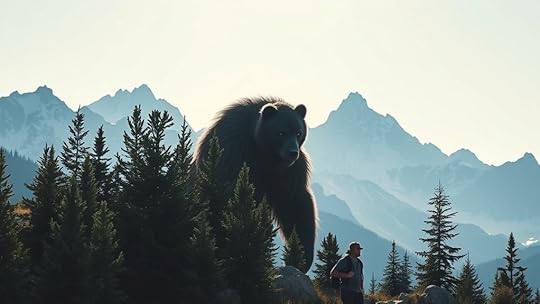
Alpine legends often blur the line between fact and fiction, making it challenging to separate genuine sightings from imaginative tales. To distinguish truth, consider these factors:
Mountain geology provides clues; unusual formations or markings might be natural rather than supernatural.Alpine flora can help verify stories—rare plants or animal tracks suggest real encounters.Eyewitness accounts should be scrutinized for consistency and detail, avoiding hearsay.Historical context, such as local lore and terrain, helps determine if stories are rooted in genuine observations or embellishments.Frequently Asked QuestionsHow Did Napoleon Supposedly Encounter the Yeti in the Alps?You might wonder how Napoleon supposedly encountered the yeti in the Alps. According to Alpine folklore, he and his men found mysterious yeti footprints deep in the snow, sparking rumors of a mysterious creature lurking in the mountains. These footprints, believed by some to be evidence of the mythical yeti, fueled stories that Napoleon’s expedition was interrupted by this elusive creature, blending myth and memoir in Alpine legends.
Are There Any Credible Scientific Explanations for the Yeti Sightings?You wonder if there’s credible science behind cryptid sightings like the yeti. While many reports stem from folklore origins and anecdotal accounts, scientific explanations often point to misidentified animals, such as bears, or psychological factors like hallucinations. Some evidence is inconclusive, but most researchers consider the yeti a myth rooted in local legends rather than a real creature. So, the scientific community remains skeptical about the existence of such cryptids.
What Role Did Local Villagers Play in Shaping the Yeti Legend?You see, local folklore heavily influences the yeti legend, as villagers’ influence shapes the stories passed down through generations. Their accounts, often exaggerated or mythologized, create a sense of mystery around the creature. By sharing tales rooted in cultural beliefs and personal encounters, villagers help preserve and spread the legend, blurring the line between myth and reality and making the yeti an enduring part of regional identity.
Could the Yeti Be a Misidentified Known Animal Species?You might wonder if the yeti is just a cryptid misidentification of known alpine fauna, a creature mistaken for something mythical. Could it be a bear, a large monkey, or other regional animals, hiding in snow and shadows? These misidentifications often stem from limited sightings or exaggerations. In this way, the yeti might simply be a reflection of human imagination, shaped by the rugged landscape and the mysteries of alpine fauna.
How Has Modern Technology Impacted Yeti Investigations in the Alps?Modern technology has revolutionized how you investigate cryptid folklore like the yeti in the Alps. You now use advanced camera traps and drones to gather photographic evidence, making sightings more verifiable. These tools help distinguish genuine encounters from hoaxes, providing clearer insight into the mysterious creature. As a result, your investigations are more scientific, allowing you to better separate myth from reality and understand whether the yeti is based on a real animal or just folklore.
ConclusionAs you sift through the legends and evidence, you realize that whether it’s a mythical creature or a mistaken sighting, the story endures. Like Napoleon’s snowbound expeditions, these tales blend fact with fiction, shaping cultural myths. You see how history and imagination collide—truth often hidden in the icy shadows, much like the elusive yeti itself. In the end, it’s the mystery that keeps the legend alive, more powerful than any proof.
The Folklore of the Will-o’-the-Wisp
The folklore of the Will-o’-the-Wisp describes mysterious flickering lights over marshes at night, often seen as spirits, fairies, or supernatural guides. These lights symbolize temptation, deception, and elusive goals, warning travelers to stay on safe paths. Cultures see them as spirits drawn by unfinished business or as divine or demonic energy. If you want to uncover more, you’ll discover how these lights reflect human curiosity and the mysteries beyond understanding.
Key TakeawaysThe Will-o’-the-Wisp is a mystical light seen over marshes, linked to spirits, fairies, or supernatural forces across cultures.It symbolizes temptation, deception, and fleeting truths, warning travelers to stay on safe paths.Originating from legends of spirits guiding or misleading, it often represents spirits of the restless dead or divine energies.Cultural attitudes view it as both awe-inspiring and dangerous, embodying the mysteries and unseen natural forces.Modern interpretations see it as a metaphor for curiosity, illusions, and the risks of pursuing elusive goals.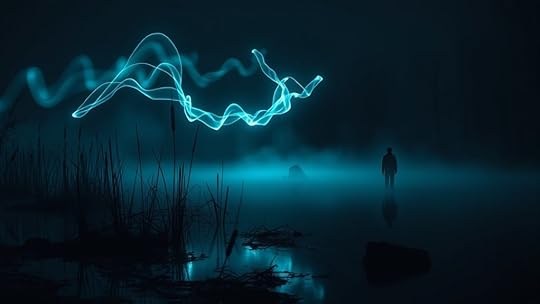
Throughout folklore across many cultures, the Will-o’-the-Wisp is known as a mysterious, flickering light that appears over marshes and bogs at night. Its origins are steeped in mystical beliefs, with many stories attributing it to supernatural forces or spirits. These tales often suggest that the light isn’t just a natural phenomenon but a sign of hidden powers or otherworldly entities guiding or misleading travelers. The mystical origins of the Will-o’-the-Wisp vary from culture to culture. In some legends, it’s believed to be the restless spirits of the dead, drawn to the earthly *domain* by unfinished business or sorrow. Others see it as a manifestation of divine or demonic energy, serving as a test or warning for those who venture into dangerous territory. In European folklore, particularly in Britain and Ireland, it’s often linked to fairy spirits or mischievous sprites that play tricks on wandering souls, leading them astray. Meanwhile, in Asian traditions, similar luminous phenomena are sometimes associated with ancestral spirits or spiritual guides, emphasizing its role as a bridge between worlds. Interestingly, the flickering nature of the light also symbolizes the fleeting and elusive nature of truth and understanding in human life. Culturally, the Will-o’-the-Wisp holds significant symbolism, often representing temptation, deception, or the pursuit of elusive goals. Its flickering, inconsistent glow mirrors the way humans chase after dreams or promises that are just beyond reach. In many stories, it’s a cautionary symbol warning travelers to stay on the safe path, as following the light could lead them into danger or eternal wandering. The light’s unpredictable nature makes it a powerful metaphor for human curiosity and the mysteries that lie beyond understanding. It also embodies the idea that appearances can be deceiving—what seems to be a helpful guide might actually be a lure designed to trap or mislead.
You can see how this symbolism influences cultural attitudes toward the unknown. The Will-o’-the-Wisp becomes a reminder that not everything that shines brightly is good or trustworthy. Its mystical origins foster a sense of awe and fear, prompting people to respect the unseen forces at play in the natural world. Over time, the light’s role in folklore evolved from a mere supernatural phenomenon to a symbol of human longing for discovery, as well as caution about the dangers of chasing after illusions. Whether viewed as a spirit, a divine sign, or a trickster’s play, the Will-o’-the-Wisp continues to captivate those who venture into the dark, embodying the mystical and symbolic power of the mysterious lights that flicker in the night.
Frequently Asked QuestionsAre There Modern Sightings or Reports of Will-O’-The-Wisp?Yes, there are modern sightings and recent reports of will-o’-the-wisp. You might come across stories from hikers or campers describing strange lights flickering over marshes or bogs at night. While some dismiss these as natural phenomena like swamp gases, others believe they’re genuine encounters with this mysterious folklore. Despite the lack of scientific proof, these recent reports keep the legend alive and continue to intrigue those who venture into the dark.
How Does the Will-O’-The-Wisp Influence Contemporary Literature?You see, the will-o’-the-wisp influences contemporary literature by weaving symbolic symbolism and poetic inspiration into stories. Writers use its mysterious glow to evoke themes of illusion, guidance, and temptation. It challenges characters—and readers—to explore ambiguity and desire. This ghostly light sparks imagination, driving poets and novelists alike to craft tales that mirror life’s elusive truths, making the will-o’-the-wisp a lasting metaphor for mystery and the unknown.
Are There Any Scientific Explanations for Will-O’-The-Wisp Phenomena?You’ll find scientific explanations for the will-o’-the-wisp involve phosphorescent minerals and atmospheric gases. These phenomena occur when decaying organic matter produces gases like methane or phosphine, which ignite or glow due to chemical reactions or contact with oxygen. This creates flickering lights often seen over marshes or swamps. While mesmerizing, these natural processes explain the mysterious lights without supernatural causes, making them a fascinating intersection of science and folklore.
What Are the Similarities Between Will-O’-The-Wisp and Other Folklore Spirits?You’ll notice that Will-o’-the-Wisp shares similarities with other folklore spirits like fairy lights or ghostly apparitions, acting as mystical guides or deceptive spirits. Both often appear in dark, mysterious settings, luring travelers with an eerie glow. These spirits symbolize temptation and the unknown, blurring the lines between guidance and misdirection, enthralling your imagination while warning you of hidden dangers lurking in the shadows.
Has the Will-O’-The-Wisp Appeared in Popular Movies or Video Games?Yes, the will-o’-the-wisp appears in popular movies and video games, often symbolizing moral ambiguity or warning characters about danger. You might see it in games like “The Witcher” or movies with mystical themes, reflecting cultural variations that link it to spirits or guides. Its presence emphasizes moral symbolism, representing temptation or elusive truths, making it a compelling element in storytelling across different cultures.
ConclusionAs you chase the flickering light of the will-o’-the-wisp, remember it’s like a mirage guiding travelers into the unknown. Just like the legend of a lost miner who followed the glow into a swamp, only to vanish, these mysterious lights remind you that some mysteries are better left unexplored. They’re a reminder that curiosity can lead you astray, but also deeper into the stories and legends that make our world endlessly enchanting.
The Tokoloshe: Mischievous Spirit of South Africa
The Tokoloshe is a mischievous, often invisible spirit from South African folklore that can cause trouble or fear. It represents deep-rooted cultural beliefs, embodying community fears and moral lessons. People use rituals and charms for protection against this spirit, especially at night. The legend highlights the importance of respecting traditions and spiritual practices. If you want to learn how the Tokoloshe influences daily lives and community values, there’s more to explore below.
Key TakeawaysThe Tokoloshe is a small, hairy, invisible creature from South African folklore, often associated with mischief and malevolence.It is traditionally invoked for protection or revenge, embodying community fears and moral lessons.Rituals and charms are used to ward off the Tokoloshe, especially during vulnerable nighttime hours.The legend highlights the importance of respecting cultural customs and spiritual practices within communities.As a cultural symbol, the Tokoloshe reflects societal values, fears, and the enduring influence of indigenous beliefs.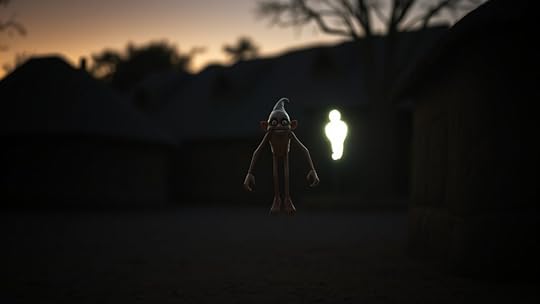
Have you ever heard of the tokoloshe, a mischievous and sometimes malevolent spirit deeply rooted in South African folklore? This creature is more than just a myth; it’s woven into the fabric of traditional beliefs that have been passed down through generations. In many communities, the tokoloshe is believed to be a small, hairy creature capable of becoming invisible at will, often summoned or invoked by those seeking revenge or protection. Its presence is thought to be a powerful reminder of the spiritual world’s influence on everyday life, making it a significant figure in the cultural landscape of South Africa.
The cultural significance of the tokoloshe extends beyond mere superstition. It embodies fears, moral lessons, and societal norms that have persisted for centuries. Traditional beliefs hold that the tokoloshe can be called upon by using specific rituals or charms, especially when someone feels vulnerable or threatened. For many, it’s a way of explaining unexplained misfortunes or illnesses, serving as a spiritual scapegoat for life’s hardships. In rural areas, stories about encounters with the tokoloshe are shared as cautionary tales, emphasizing the importance of respecting elders, honoring spiritual practices, and maintaining social harmony. These stories reinforce community values and serve as a means of cultural transmission, ensuring that the legend remains relevant and alive.
You might also find that the tokoloshe’s cultural significance is reflected in local ceremonies and protective practices. Some communities wear talismans or perform rituals to keep the spirit at bay, especially at night when the tokoloshe is believed to be most active. These practices aren’t just superstitions—they’re a way of connecting with traditional beliefs that emphasize spiritual protection and communal well-being. The tokoloshe, thus, acts as both a cautionary figure and a symbol of the unseen forces that influence daily life. Its presence underscores the importance of spiritual awareness, respect for cultural customs, and the ongoing relevance of indigenous beliefs in contemporary South Africa. Additionally, the tokoloshe often represents a embodying community fears and moral lessons passed down through generations.
Ultimately, understanding the tokoloshe’s role in South African culture reveals how traditional beliefs shape social behavior and worldviews. It’s a reminder that folklore isn’t just entertainment—it’s a reflection of history, morality, and the collective psyche of a community. Whether feared or revered, the tokoloshe remains an enduring symbol of South Africa’s rich cultural tapestry, illustrating how stories and spirits continue to influence lives long after they are told.
Frequently Asked QuestionsAre There Modern Sightings of the Tokoloshe Today?Yes, there are modern sightings of the Tokoloshe today, mostly as urban legends shared in communities and online. You might hear stories from locals claiming they’ve seen or felt its presence, especially at night or in remote areas. These modern sightings keep the myth alive, blending traditional beliefs with contemporary fears. Despite lacking concrete evidence, the Tokoloshe remains a fascinating part of South African folklore that continues to intrigue and scare people.
How Do Locals Protect Themselves From the Tokoloshe?You can protect yourself from the tokoloshe by using protective charms, as folklore beliefs suggest. Many locals place objects like salt, amulets, or even sit with their head covered to ward off this mischievous spirit. Think of these rituals as shields, guarding you from harm. While the stories are rooted in tradition, they serve as a reminder of cultural beliefs that keep the legend alive and your fears at bay.
Is the Tokoloshe Linked to Any Specific Cultural Rituals?The Tokoloshe is linked to traditional rituals where locals seek spiritual protection. You might participate in ceremonies or perform specific rituals, like placing charms or amulets under your pillow, to ward off its mischievous influence. These cultural practices are believed to invoke protective spirits or ancestors, ensuring your safety. Engaging in these traditional rituals helps maintain spiritual balance and keeps the Tokoloshe at bay, according to local beliefs.
Can the Tokoloshe Be Summoned or Controlled?You can’t truly summon or control the Tokoloshe, as it’s believed to be a mischievous spirit beyond human manipulation. Instead, people use spiritual manipulation and ritual prevention to keep it at bay. These practices involve charms, prayers, or traditional rituals that protect against its influence. Attempting to directly summon or control the Tokoloshe isn’t advisable, as it’s thought to be unpredictable and best kept away through respectful spiritual precautions.
What Are the Origins of the Tokoloshe Legend?The legend of the tokoloshe has mythical origins rooted in South African folklore development. You’ll find that it likely started as a way to explain strange or frightening events, blending traditional beliefs and cultural stories. Over time, these tales evolved, shaping a mythic figure that embodies mischievous spirits. The tokoloshe’s origins reflect the rich cultural history, serving as a symbol of supernatural forces in local narratives and societal fears.
ConclusionAs you explore the tokoloshe’s mysterious world, remember that over 60% of South Africans believe in its power, highlighting its deep cultural significance. This mischievous spirit isn’t just folklore—it’s woven into daily life and stories, reminding you of the rich traditions that shape South Africa. So next time you hear a strange noise or feel uneasy at night, consider the tokoloshe might be lurking nearby, mischievously watching.
November 25, 2025
Monster Myths in Advertising and Tourism
Monster myths like Bigfoot and Nessie are powerful tools in advertising and tourism. They spark curiosity, evoke adventure, and create a sense of mystery that draws visitors and customers alike. Towns and brands use these legends to boost local economies and attract attention through festivals, stories, and marketing campaigns. The allure of the unknown keeps the myths alive, encouraging exploration and wonder. If you keep exploring, you’ll discover how these stories shape culture and generate excitement worldwide.
Key TakeawaysCryptids are used in advertising to evoke curiosity and adventure, leveraging their mysterious and mythical appeal.Tourist destinations promote legends and sightings of monsters like Nessie or Bigfoot to attract visitors.Mythical creature stories boost local economies through monster festivals and themed attractions.Legends enhance cultural identity by symbolizing mystery and encouraging exploration beyond ordinary experiences.Advertising exploits cryptid ambiguity to generate intrigue, promising excitement and breaking routine for audiences.
Many advertising campaigns and tourist attractions rely on the allure of monsters to captivate audiences and boost interest. This strategy taps into our fascination with cryptid sightings and legendary creatures, which have long fueled stories and myths that spark curiosity. When you see a billboard or visit a local site claiming to be home to a mysterious beast, it’s no accident—these stories play on our desire for adventure and the unknown. Cryptids like Bigfoot, the Loch Ness Monster, or the Chupacabra aren’t just legends; they’re cultural phenomena that stir the imagination. They serve as powerful symbols of mystery, inviting you to explore beyond the ordinary. Interestingly, some of these stories persist despite minimal evidence, highlighting the enduring power of myth in popular culture.
Tourist destinations often leverage these mythical creatures to attract visitors eager for a taste of the supernatural. For example, towns might host monster festivals or claim sightings to generate buzz and bring in tourism dollars. You might find yourself drawn to a lake purportedly haunted by Nessie, or a forest rumored to be the home of Bigfoot. These stories create a sense of intrigue and adventure, encouraging you to explore the landscape with a sense of wonder. Sometimes, the legends are supported by minimal evidence, but that doesn’t diminish their power to attract tourists or boost local economies. In fact, the more elusive and mysterious the creature, the more captivating the story becomes.
Advertising campaigns often play on the ambiguity surrounding legendary creatures, using cryptid sightings to evoke curiosity. They might feature grainy images, eyewitness stories, or folklore that suggest something extraordinary is lurking nearby. You might be enticed to visit a theme park that promises encounters with mythical monsters or to buy souvenirs inspired by these stories. These tactics turn mythical monsters into marketing tools, making them part of a broader narrative that promises adventure, excitement, and a break from the mundane. The allure of these creatures lies in their mystery—they’re often just out of reach, yet tantalizing enough to keep your imagination engaged.
Frequently Asked QuestionsHow Do Monster Myths Influence Consumer Behavior Beyond Advertising?Monster myths influence your behavior by shaping myth-based branding that taps into deep-seated fears and desires. Fear-driven marketing uses these stories to create urgency, making you more likely to engage with products or experiences that promise safety or excitement. You might avoid certain brands or destinations or be drawn to others that evoke a sense of adventure or security, as these myths tap into your subconscious and influence your decision-making.
Are There Cultural Differences in How Monster Myths Are Perceived Globally?You’ll find that cultural variations paint different pictures of monster myths worldwide, shaping unique perceptions. In some places, monsters symbolize fear and chaos, while in others, they embody wisdom or protection. These global perceptions act like a kaleidoscope, reflecting diverse values and beliefs. Recognizing these cultural nuances helps you understand that monster myths are not universal; instead, they are vibrant threads woven into each society’s unique fabric.
What Psychological Effects Do Monster Myths Have on Tourists’ Perceptions?You might find that monster myths trigger fear reinforcement, making some tourists feel more cautious or anxious about unfamiliar places. At the same time, these stories stimulate curiosity, encouraging you to explore beyond your comfort zone. This dual effect influences perceptions, making destinations seem both intriguing and potentially threatening. Your reactions depend on how the myths are presented and your personal experiences, shaping your overall impression of the location.
How Do Companies Ethically Leverage Monster Myths in Marketing Strategies?You can ethically leverage monster myth commercialization by focusing on storytelling that respects cultural roots and promotes local heritage. Emphasize authentic narratives that celebrate legend without exploiting fears or stereotypes. By prioritizing ethical storytelling, you build trust with your audience and create meaningful experiences. Use these myths to inspire curiosity and wonder, rather than manipulation, ensuring your marketing strategy honors tradition while engaging consumers responsibly.
Can Monster Myths Contribute to Sustainable Tourism Development?Monster myths can positively contribute to sustainable tourism development by promoting eco tourism development and encouraging responsible travel. When you use mythical creature branding, you attract visitors interested in local legends, fostering cultural preservation and environmental awareness. This approach helps create unique experiences that support local communities while protecting natural resources. Embracing these myths sustainably guarantees tourism growth benefits everyone involved without harming the environment or cultural heritage.
ConclusionAs you navigate advertising and tourism, remember how myths shape perceptions—like the legend of Loch Ness, which keeps visitors searching for the unknown. Just as that mythical monster draws curiosity and excitement, your stories can spark wonder and trust. When you harness these myths thoughtfully, you turn ordinary destinations into magical places that invite exploration. So, embrace the power of myth—because sometimes, believing in a little magic is what makes a journey unforgettable.
The Green Children Revisited: Possible Explanations
The Green Children story has intrigued many because of its mythical and scientific possibilities. You might see them as supernatural beings from folklore, like spirits or elves, or as victims of environmental factors such as toxins or genetic anomalies. These explanations weave fantasy with science, keeping the mystery alive. If you’re curious to explore more about their origins and what each theory suggests, there’s a fascinating world behind this enduring legend just ahead.
Key TakeawaysMythical origins suggest children are supernatural beings like fairies or spirits from local folklore.Environmental factors, such as exposure to rare minerals or toxins, may explain their green skin and speech.Scientific theories explore genetic anomalies or environmental stressors as plausible explanations.Cultural significance links their story to regional legends, enhancing its mystique and historical relevance.The enduring mystery reflects human curiosity, blending folklore with scientific inquiry to interpret their origins.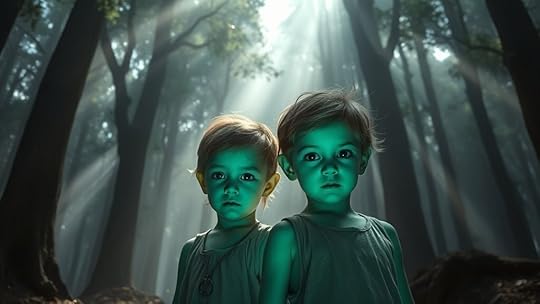
The story of the Green Children continues to captivate and mystify those who hear it, revealing how legends can endure through centuries. When you look into their origins, you quickly realize that many theories attempt to explain their strange appearance and mysterious background. One popular idea suggests mythical origins, proposing that these children might be supernatural beings or part of a mythic tale woven into local folklore. This theory points to stories rooted in ancient legends where otherworldly creatures or enchanted beings often appeared with unusual traits. Some believe the children could be symbols of supernatural forces, perhaps linked to legends of fairies, elves, or spirits that once populated the region. These mythical origins lend a fantastical quality to the story, making it difficult to dismiss outright, even today. Still, you might find that some interpretations lean toward something less mystical and more plausible, such as environmental theories.
Environmental theories propose that the children’s strange appearance and behavior could be the result of unusual environmental factors or health conditions. For example, exposure to rare minerals, toxic plants, or chemical pollutants could have caused physical changes or illnesses that made them appear otherworldly. Some researchers suggest that environmental stressors or dietary deficiencies might explain their green skin tone and strange speech. Others hypothesize that they might have been victims of some form of mutation or genetic anomaly caused by local environmental factors. This perspective emphasizes that the children’s story might not be rooted in myth but rather in real, tangible circumstances that were misunderstood or exaggerated at the time. Additionally, advancements in scientific understanding can provide insights into possible environmental influences on their condition. Environmental explanations can also account for the children’s unfamiliar language, suggesting they might have been from a remote or isolated community with different customs and dialects, which outsiders misinterpreted as otherworldly.
In exploring these theories, you see how the mythic and environmental explanations serve different purposes. Mythical origins evoke wonder, linking the children to stories of the supernatural and the unexplained. Environmental theories, on the other hand, aim to provide a tangible, scientific basis for their strange characteristics, rooted in real-world phenomena. Both perspectives highlight the enduring mystery and the human desire to find meaning, whether through supernatural tales or scientific inquiry. As you investigate more into the legend, it becomes clear that the Green Children’s story is a complex blend of folklore, speculation, and curiosity—an enduring enigma that still invites wonder, explanation, and debate centuries later.
Frequently Asked QuestionsAre There Modern Sightings Similar to the Green Children?Yes, you can find modern sightings that resemble the Green Children, often linked to mythical origins and folklore parallels. People report encounters with mysterious, otherworldly children or beings, sparking speculation about supernatural or extraterrestrial origins. These stories echo ancient legends of strange children emerging from hidden places, blending myth and reality. While skeptics dismiss them as hoaxes or hallucinations, believers see them as ongoing mysteries rooted in folklore traditions.
What Cultural Influences Shaped the Green Children Legends?You should know that cultural influences like mythical origins and folkloric symbolism deeply shape the green children legends. These stories often draw from ancient myths about otherworldly beings or nature spirits, reflecting society’s fascination with the mysterious and the supernatural. Folklore uses symbolism to convey moral lessons or cultural values, which helps explain why these legends persist across generations, blending myth, legend, and cultural identity into enthralling stories.
Could the Children Have Been Extraterrestrial Visitors?You might think the green children were extraterrestrial visitors, supporting the alien encounter and extraterrestrial hypothesis. Their unusual appearance and mysterious origins could point to an otherworldly encounter, sparking speculation about alien life. While there’s no concrete evidence, the idea that they came from space offers a compelling explanation for their green skin, strange language, and sudden appearance, fueling ongoing fascination with the possibility of extraterrestrial contact.
How Have Local Communities Responded Historically?Local communities have often responded with a mix of fascination and skepticism, like a pendulum swinging between belief and doubt. They’ve woven tales into local folklore, celebrating the mysterious green children as part of their cultural tapestry. Yet, community skepticism remains strong, prompting authorities and residents to question the stories. This tension sparks ongoing debates, keeping the legend alive while grounding it in cautious disbelief.
Are There Scientific Theories Explaining Their Appearance?Scientists explore biological anomalies and psychological phenomena to explain the Green Children’s appearance. You might consider that rare genetic mutations or exposure to environmental factors could cause unusual skin pigmentation, fitting biological explanations. Alternatively, psychological phenomena like mass hysteria or hallucinations might account for perceived sightings. While no definitive scientific consensus exists, these theories offer plausible insights into the mysterious green children’s origins, prompting ongoing investigation and debate.
ConclusionAs you reflect on the green children’s story, you realize they symbolize innocence lost and the unknown awaiting discovery. Their otherworldly hue hints at hidden truths lurking beneath surface appearances, urging you to look beyond the obvious. Just as their arrival challenges your understanding, you’re reminded that mysteries often serve as mirrors, inviting you to explore deeper truths within yourself. In embracing the enigmatic, you open the door to new perspectives, where the unknown becomes a beacon of hope and insight.
The Gurt Dog of Somerset: Benevolent Black Dog
The Gurt Dog of Somerset is a rare, benevolent black dog spirit known for its protective nature rather than causing fear. You might encounter its sleek, shiny form on lonely country roads or near ancient ruins, where it offers reassurance and guidance. Unlike the ominous Black Shuck, this guardian creature embodies safety and comfort, symbolizing Somerset’s wilderness and mystery. If you want to discover more about this unique legend, there’s much more to explore beyond this introduction.
Key TakeawaysThe Gurt Dog is a benevolent black dog from Somerset folklore, serving as a guardian rather than a malevolent spirit.It appears as a sleek, shiny black figure, offering reassurance and protection on lonely roads and ancient sites.Unlike typical black dog legends, the Gurt Dog symbolizes safety, guiding and guarding villagers and travelers.Stories depict the Gurt Dog as a spirit reincarnation that embodies Somerset’s wilderness and protective qualities.Its folklore emphasizes themes of reassurance and safety, making it a unique, benevolent figure in local mythology.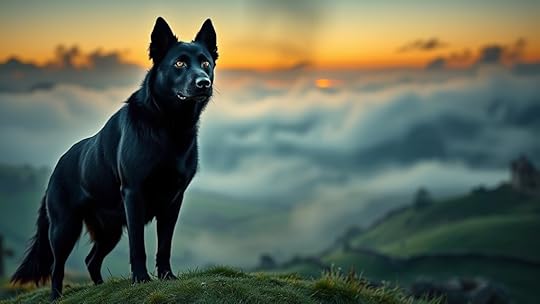
Have you heard about the Gurt Dog of Somerset? If not, you’re missing out on a fascinating piece of local folklore that’s deeply rooted in Somerset legends. The Gurt Dog is a rare twist on the typical black dog folklore, which often features ominous, ghostly creatures lurking in the shadows. Unlike many of its counterparts, this black dog is believed to be benevolent rather than malevolent. It’s said to appear in times of trouble or danger, serving as a guardian rather than a harbinger of doom. Stories of the Gurt Dog have been passed down through generations, weaving a rich tapestry of myth that’s both intriguing and comforting to locals. Its benevolent nature sets it apart from the more commonly feared black dog legends, highlighting its role as a protector rather than a threat.
In Somerset legends, the Gurt Dog’s appearance is often associated with protective qualities. Unlike the infamous Black Shuck, which is sometimes seen as a sign of impending disaster, the Gurt Dog is viewed as a watchful protector. People tell tales of encountering this black canine on lonely country roads or near ancient ruins, where it offers reassurance rather than fear. Its presence is seen as a sign that help is near or that a negative event has been averted. Many believe the Gurt Dog embodies the spirit of Somerset’s wilderness—mysterious, powerful, yet fundamentally good. Its black coat, often described as shiny and sleek, adds to its spectral and enigmatic aura, fueling the imagination of those who hear its stories.
This benevolent black dog is also linked to local folklore about spirits and guardian creatures. In some stories, it is said that the Gurt Dog is the spirit of a protector who once lived in the area, reincarnated to watch over travelers and villagers. Its role is to guide and guard, rather than intimidate or frighten. Sightings are rare, and many who claim to have seen the Gurt Dog describe it as a comforting presence, almost like a silent sentinel watching over them from the darkness. These stories have helped cement the Gurt Dog’s place in Somerset’s cultural history, making it a unique figure amidst the more ominous tales of black dogs in folklore.
Frequently Asked QuestionsAre There Any Recent Sightings of the Gurt Dog?Yes, there have been recent sightings of the Gurt Dog, which keeps local beliefs alive in modern folklore. You might hear stories from residents claiming they’ve seen this benevolent black dog roaming Somerset’s countryside. These sightings often spark curiosity and reinforce the legend’s place in local tradition. While some dismiss them as tales, others believe the Gurt Dog still watches over the area, blending history with contemporary folklore.
What Is the Origin of the Gurt Dog Legend?You learn that the legend origins of the Gurt Dog stem from Somerset folklore history, where it’s believed to be a benevolent black dog guiding or protecting villagers. This folklore suggests the Gurt Dog’s presence is linked to ancient stories passed down through generations, symbolizing good luck or spiritual guidance. Its mysterious nature adds to the rich tapestry of regional legends, blending myth and history to create a enthralling local folklore symbol.
Has Anyone Ever Captured Photographic Evidence of the Gurt Dog?You might be surprised, but no one has ever officially captured photographic evidence of the Gurt Dog despite recent sightings. Coincidences happen when people stumble upon strange shadows or fleeting figures, fueling stories. While many claim to have seen the black dog, no clear photos have surfaced, leaving its existence in mystery. Your curiosity might lead you to the right moment to get that rare shot someday.
How Does the Gurt Dog Compare to Other Black Dog Legends?You’ll find that the Gurt Dog differs from other Black Dog Encounters because it’s seen as benevolent rather than ominous, unlike many folklore variations. While most legends depict these creatures as harbingers of doom, the Gurt Dog offers protection and guidance. Its unique nature sets it apart, making it a fascinating twist in black dog folklore. You might notice that this positive portrayal influences local stories and how people interpret similar encounters.
Are There Specific Locations in Somerset Known for Gurt Dog Sightings?You’ll find that specific locations in Somerset are renowned in local folklore for Gurt Dog sightings, especially around ancient woods and rural countryside. Historical sightings often mention these areas as hotspots where villagers once saw the benevolent black dog. If you explore places like the Quantock Hills or the Mendip Hills, you might stumble upon stories or even glimpses tied to this legendary, protective creature.
ConclusionAs you ponder the Gurt Dog of Somerset, remember that every legend whispers truths about our fears and hopes—much like the black dog of folklore, silently watching from the shadows. It’s a reminder that beneath the surface of every myth lies a reflection of ourselves, echoing the silent guardians and unknown dangers we face. Embrace the mystery, for in its depths, you may find both caution and comfort, much like the silent guardian that roams Somerset’s darkened moors.
The Almas: Mongolian Wild Man
The Almas is a legendary creature from Mongolian folklore, often described as a hairy, ape-like being that roams remote mountain regions. Witnesses report fleeting glimpses, strange footprints, and eerie vocalizations in rugged terrains. These stories serve as cautionary tales and reflect the region’s mysterious wilderness. Despite modern efforts using cameras and recordings, no conclusive proof has been found. If you explore further, you’ll discover more about this intriguing symbol of primal wilderness.
Key TakeawaysThe Almas is a legendary, elusive, ape-like creature rooted in Mongolian nomadic folklore, often linked to wilderness mysteries.Sightings include strange footprints and fleeting glimpses in remote mountainous and forested areas of Mongolia.Folklore portrays the Almas as shy, intelligent, and symbolic of primal wilderness, serving as cautionary stories.Modern efforts use trail cameras and audio recordings to document the creature, though no conclusive evidence exists.The legend reflects human fascination with unknown creatures, possibly representing relics of prehistoric ancestors or undiscovered primates.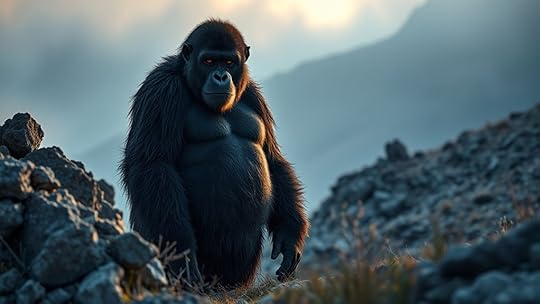
Have you ever wondered if the legendary Mongolian wild man, known as the Almas, truly exists? This mysterious creature has captured the imagination of explorers, locals, and cryptid enthusiasts for generations. Reports of cryptid sightings across the remote mountains and forests of Mongolia fuel the curiosity surrounding the Almas, making it one of Asia’s most enduring folklore legends. Many believe that these sightings stem from actual encounters with a creature resembling a primitive human, while others see them as part of cultural storytelling that has been passed down through centuries. The folklore origins of the Almas are deeply rooted in the nomadic tribes’ traditions, where tales of a hairy, ape-like being serve as cautionary stories or explanations for unexplained noises and strange footprints in the wilderness. These stories often depict the Almas as elusive, shy, and sometimes even intelligent, leading some to speculate that it could be a surviving relic of a prehistoric ancestor or an undiscovered primate species.
Throughout history, villagers and explorers have reported strange tracks, unusual vocalizations, and fleeting glimpses of a large, hairy figure lurking in the mountains. These cryptid sightings tend to occur in rugged terrain, where the dense forests and high elevations make it easier for the creature to evade human discovery. While definitive evidence remains elusive, the consistency of these reports keeps the legend alive. Many local traditions describe the Almas as a creature possessing human-like intelligence, capable of avoiding detection, and sometimes even exhibiting signs of curiosity toward humans. This blend of folklore origins and cryptid sightings weaves a compelling narrative that captures the imagination of those interested in the unknown. Additionally, modern technology such as trail cameras and audio recordings has been used in attempts to document these elusive beings, but conclusive proof remains absent.
Despite the lack of scientific proof, the stories persist, partly because they resonate with the deep-seated human fascination with the mysterious and the wild. Some researchers suggest that the Almas might be a cultural manifestation—an allegory for the untamed wilderness or a symbol of humanity’s primal past. Others remain skeptical, arguing that many sightings can be attributed to misidentification of bears, mountain goats, or other large animals. Yet, the legend endures because it taps into the universal human desire for discovery and the thrill of encountering something truly unknown. Whether the Almas is a real creature or a folkloric relic, it continues to inspire stories, folklore origins, and cryptid sightings that remind us how much of the world remains unexplored and mysterious.
Frequently Asked QuestionsAre There Recent Sightings of the Almas?Recent cryptid sightings of the almas continue to surface, fueling local folklore origins and intrigue. You might hear stories from remote Mongolian villages claiming encounters with this elusive wild man, described as a hairy, humanoid creature. These accounts often blend tradition with mystery, keeping the legend alive. While no scientific evidence confirms these sightings, they persist in folklore, inspiring explorers and cryptid enthusiasts to seek out the almas in its natural habitats.
What Evidence Supports the Existence of the Almas?Think of the Almas as a shadow cast by folklore traditions, whispering of something unseen. Scientific skepticism questions any concrete evidence, yet some footprints, hair samples, and eyewitness accounts hint at a possible wild inhabitant. While these clues spark curiosity, they lack definitive proof. You’re left to weigh tradition’s stories against scientific rigor, recognizing that the Almas remains an intriguing mystery lurking between myth and reality.
How Do Local Legends Describe the Almas?You hear that local legends describe the almas as a mysterious, hairy creature with mythical origins, often seen roaming remote mountain areas. These stories emphasize its elusive nature and spiritual significance, portraying it as a symbol of wilderness and ancient traditions. According to locals, encounters with the almas carry cultural importance, reflecting a deep connection with nature and ancestral beliefs, making it a revered and intriguing part of regional folklore.
Have Any Researchers Studied Almas Habitats?Did you know researchers have studied almas habitats extensively? They focus on habitat preferences and ecological niches, often finding almas prefer remote mountain ranges and dense forests. These environments provide cover and abundant food sources, making them ideal for survival. By analyzing these habitats, researchers aim to understand their behavior and distribution better, though concrete evidence remains elusive. Your curiosity about almas habitats could lead to uncovering fascinating ecological insights.
What Are the Differences Between Almas and Bigfoot?You’ll find that almas and Bigfoot differ in their origins and appearances within mythical creatures and folklore. Almas, rooted in Mongolian folklore, are often described as hairy, human-like beings living in remote mountain regions. Bigfoot, from North American legends, is also a large, ape-like creature but with different cultural stories and sightings. While both are elusive, folklore origins shape how each creature is perceived and studied, highlighting regional differences in mythical creature tales.
ConclusionSo, next time you hear about the Almas, remember they might just be real, elusive creatures lurking in Mongolia’s wilds. Some dismiss them as myths, but many believe they’re ancient survivors, hiding from humans. Whether you think they’re legends or living beings, their mystery sparks our curiosity. Maybe, just maybe, exploring these stories reminds us how much we still don’t know about our world’s hidden wonders. Keep questioning—adventure and discovery await!
Mysterious Paw Prints on the Rosetta Stone: Conservation Notes
You notice faint paw prints on the Rosetta Stone, likely caused by animals or accidental contact over time. Conservation teams have taken immediate steps to clean, stabilize, and protect the surface, using advanced technologies like 3D scanning and non-invasive imaging. To prevent further damage, they restrict access and monitor conditions regularly. If you want to uncover more about the challenges and solutions involved in preserving this historic artifact, there’s much more behind the surface.
Key TakeawaysInitial observations suggest the paw prints are accidental, likely caused by animals or environmental factors during handling or storage.Conservation efforts include surface cleaning, surface consolidants, and protective barriers to prevent further deterioration.Advanced imaging techniques like 3D scanning and non-invasive analysis aid in documenting and understanding the marks without damaging the stone.Ongoing monitoring and collaboration among archaeologists, conservators, and scientists are essential to detect early signs of damage.Future preservation aims focus on understanding cultural significance, improving monitoring methods, and preventing further deterioration of the artifact.Historical Context of the Rosetta Stone and Its Significance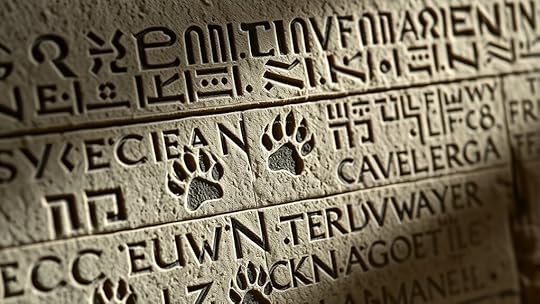
The Rosetta Stone emerged during a time of political upheaval in Egypt, around 196 BCE, when the Ptolemaic dynasty ruled following Alexander the Great’s conquest. This artifact holds immense cultural significance, serving as a symbol of ancient Egyptian authority and knowledge. Its inscriptions feature hieroglyphs, Demotic script, and Greek, reflecting Egypt’s diverse influences and complex history. As you examine it, you’ll notice the stone’s carvings incorporate ancient symbolism, revealing religious and political meanings embedded in the text. The Rosetta Stone became a vital key for deciphering hieroglyphs, *uncovering* Egypt’s rich history. Its cultural significance extends beyond language, representing a bridge between ancient Egyptian civilization and modern understanding. This context helps you appreciate its enduring importance in historical and archaeological studies.
Discovery of the Paw Prints and Initial Observations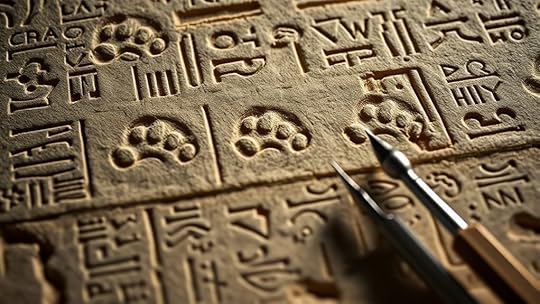
While examining the Rosetta Stone more closely, curious markings caught your eye—faint paw prints etched into the surface. At first, you thought they might be animal footprints, but their irregular pattern suggested something else. These accidental markings seem to have been made unintentionally, perhaps during handling or storage. The paw prints are subtle, but their presence raises questions about the stone’s history and exposure. You notice that the prints lack the clarity of deliberate carvings, indicating they were likely made by an animal walking across the surface. This initial observation sparks curiosity about how these accidental markings formed and what circumstances led to this unlikely discovery. It’s a reminder that even minor details can reveal unexpected stories behind historical artifacts.
Analysis of Possible Causes Behind the Marks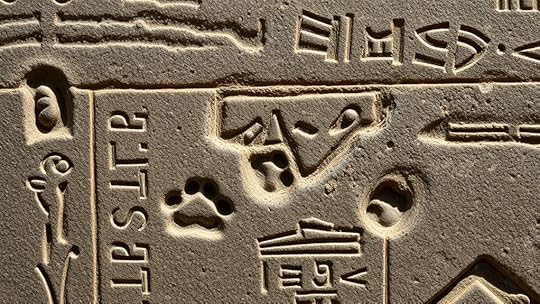
Considering the subtle nature of the paw prints, several possible causes could explain how they came to be on the Rosetta Stone. One possibility is animal tracking, where small animals, like rodents or cats, might have moved across the surface, leaving prints behind. Surface contamination is another plausible cause; dust, dirt, or other particles could have transferred onto the stone, creating the appearance of paw marks. Environmental factors, such as humidity or temperature changes, might have facilitated the transfer of these marks from nearby surfaces or animals. It’s also possible that accidental contact during handling or storage introduced the prints. While these explanations seem plausible, further analysis is necessary to determine the exact cause behind the mysterious marks.
Challenges in Preserving the Carvings and Surface Integrity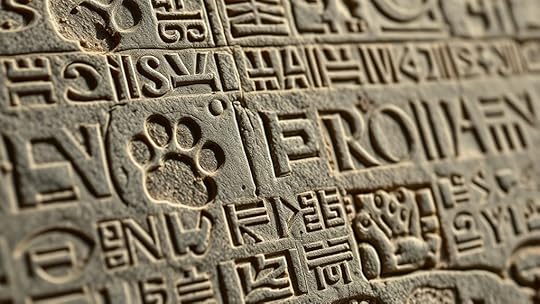
You face the constant threat of surface erosion that can gradually wear away the carvings. Preserving the stone’s integrity is complicated by the limitations of current techniques, which may not fully protect or restore it. Addressing these challenges is vital to guarantee the carvings remain visible for future generations.
Surface Erosion RisksSurface erosion poses a significant challenge to preserving the carvings on the Rosetta Stone, as natural elements gradually wear down its surface over time. Microbial corrosion accelerates this process, as bacteria and fungi break down minerals, weakening the stone’s structure. Chemical degradation also plays a role, with pollutants like acids and salts reacting with the surface, causing pitting and flaking. These processes threaten the visibility and integrity of the carvings, making preservation difficult. Environmental factors like humidity, temperature fluctuations, and pollution contribute to erosion, compounding the damage. To protect the stone, conservators must carefully monitor these risks and implement strategies that minimize exposure to harmful elements, ensuring the carvings remain legible and the surface remains as stable as possible for future study.
Preservation Technique ChallengesPreserving the carvings and surface integrity of the Rosetta Stone presents significant challenges due to the delicate balance between conservation methods and the stone’s natural vulnerabilities. You must consider restoration ethics, ensuring interventions do not alter or damage the original surface. Material stability becomes critical, as ancient stone can weaken or react adversely to certain treatments. Selecting appropriate preservation techniques involves weighing risks and benefits carefully. You can’t rely solely on modern methods; they must respect the artifact’s historical context. Achieving long-term stability without compromising authenticity demands meticulous planning. Preservation efforts must address both the physical integrity of the stone and the preservation of its carvings, often requiring innovative approaches that balance scientific precision with ethical responsibility.
Conservation Strategies and Immediate Actions Taken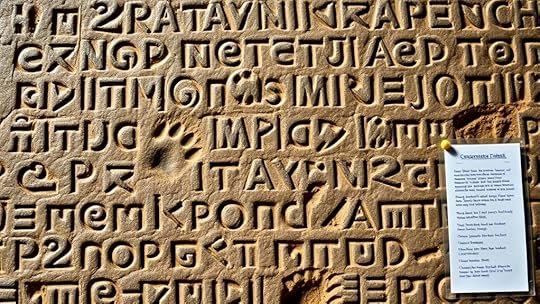
In response to the damage sustained by the Rosetta Stone, conservation teams swiftly implemented a combination of targeted strategies and immediate actions to stabilize and protect the artifact. They prioritized restoration ethics by ensuring that interventions preserved the stone’s integrity without introducing unnecessary alterations. To minimize visitor impact, access was temporarily restricted, and protective barriers were installed. Specialists carefully cleaned the surface to remove debris without risking further harm. They also applied consolidants to strengthen weak areas, balancing preservation with respect for the artifact’s historical authenticity. These steps aimed to halt ongoing deterioration while maintaining the artifact’s cultural significance. By acting promptly and ethically, the team sought to ensure the Rosetta Stone remains intact for future study and public appreciation.
Future Monitoring and Research Initiatives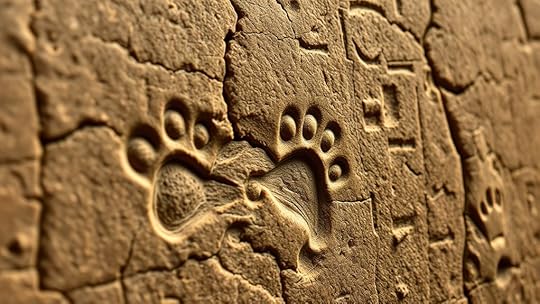
Looking ahead, you’ll want to focus on ongoing preservation efforts that guarantee the stone’s longevity. Advanced imaging techniques can reveal new insights without causing damage, while collaborative research projects bring together experts worldwide. Together, these initiatives will help safeguard and deepen understanding of this priceless artifact.
Ongoing Preservation EffortsAs conservationists continue to safeguard the Rosetta Stone, they are implementing advanced monitoring technologies and research initiatives to guarantee its long-term stability. These efforts focus on detecting and preventing animal intrusion, which can threaten the artifact’s integrity. You’ll see sensors tracking humidity, temperature, and vibrations, providing real-time data to catch any signs of deterioration early. Conservation teams also conduct regular inspections to assess physical condition and identify new risks. By staying vigilant, they aim to preserve the stone’s inscriptions and prevent further damage.
Use of remote sensors for continuous monitoringRegular physical inspections for early detectionResearch on environmentally friendly preservation methodsAdvanced Imaging TechniquesAdvanced imaging techniques are set to revolutionize how conservationists monitor the Rosetta Stone’s condition in the future. Thermal imaging allows you to detect temperature variations that reveal hidden cracks, moisture, or previous restorations without contact. This non-invasive method helps you identify issues early, guiding timely interventions. Digital reconstruction enables you to create detailed 3D models of the stone, capturing its current state with precision. By comparing these models over time, you can track subtle changes and deterioration. These techniques give you a clearer understanding of the stone’s health, aiding conservation efforts. As technology advances, you’ll gain even more accurate tools for preserving this ancient artifact, ensuring that future research can address problems before they become visible to the naked eye.
Collaborative Research ProjectsCollaborative research projects are essential for advancing the monitoring and preservation of the Rosetta Stone. By pooling expertise from archaeologists, linguists, and conservationists, you can uncover new insights into ancient symbolism and animal footprints that may be linked to the mysterious paw prints. These initiatives help track long-term changes and develop innovative preservation strategies. Through joint efforts, you might discover whether the footprints hold cultural significance or are recent additions. You’ll also benefit from interdisciplinary techniques, such as 3D scanning and chemical analysis, to deepen understanding.
Share findings on ancient symbolism connected to animal footprintsDevelop new conservation methods through international cooperationMonitor the stone’s condition over time to prevent deteriorationFrequently Asked QuestionsWhat Animal Likely Left the Paw Prints on the Rosetta Stone?You might wonder which ancient animal left the paw prints. Given the size and shape, it’s unlikely to be a predator, so it could have been a small, domesticated creature or a non-predatory animal. The paw prints suggest an ancient animal that was probably harmless and curious, like a feline or a small dog. It’s fascinating to think about how these traces connect us to the past, even if the exact animal remains a mystery.
Could the Paw Prints Have Historical Significance or Cultural Meaning?You might wonder if the paw prints have any symbolic meaning or ritual significance. It’s possible they do, reflecting cultural beliefs or spiritual practices involving animals. In some societies, animal footprints symbolize protection or divine presence. If the paw prints hold such importance, they could reveal insights into past rituals or beliefs, offering a deeper understanding of the culture’s relationship with nature and the spiritual world.
Are Similar Paw Prints Found on Other Ancient Artifacts?Did you know that only 5% of ancient artifacts show clear animal markings? Similar paw prints are rare but do appear on some artifacts, offering insights into ancient animal behavior and their interactions with humans. These markings highlight the importance of artifact preservation, as they can reveal cultural practices or natural occurrences. Recognizing such patterns helps us understand past environments and animal influences on ancient societies.
How Do Conservationists Differentiate Between Natural and Accidental Marks?You can differentiate between natural and accidental marks by using iconography analysis and examining contextual evidence. Conservationists look at the style, placement, and pattern of the marks, comparing them to known symbols or damage types. If the marks align with typical iconography or fit within the artifact’s historical context, they’re likely intentional. Otherwise, they’re probably accidental or caused by environmental factors, helping you determine their origin accurately.
What Long-Term Effects Might the Paw Prints Have on the Stone’S Preservation?You might worry that the paw prints could cause long-term damage, leading to biological deterioration or surface erosion of the stone. Over time, these marks can trap moisture or encourage mold growth, accelerating decay. If conservation efforts don’t address these issues, the stone’s surface could weaken, risking loss of historical details. Proper preservation methods are essential to safeguard against further deterioration and ensure the stone’s longevity.
ConclusionImagine holding a fragile treasure, knowing it’s vulnerable to unseen threats. The paw prints on the Rosetta Stone remind you that even the most iconic artifacts face unexpected challenges. Like a watchful guardian, your careful conservation efforts guarantee these marks don’t erase history’s story. With each monitoring step, you’re safeguarding a silent witness to human achievement—proving that preservation is an ongoing journey, not a one-time act. Your vigilance keeps history alive for generations to come.
November 24, 2025
The White Lady: Ghostly Archetypes Across Cultures
The White Lady is a widespread ghostly figure found in many cultures, symbolizing themes like loss, longing, and justice. In Western legends, she often appears as a tragic bride or woman symbolizing grief and betrayal, serving as moral warnings. In Asian stories, she’s seen as a protective or benevolent spirit tied to ancestral memories. These archetypes reflect deep cultural values and collective fears, offering insight into societal morals. Explore further to uncover the rich stories behind this timeless apparition.
Key TakeawaysThe White Lady archetype symbolizes loss, longing, justice, and unresolved grief across various cultures worldwide.In Western folklore, she often represents tragic love, betrayal, and moral lessons through ghostly appearances.Asian legends depict the White Lady as a protective or benevolent spirit, embodying spiritual purity and ancestral reverence.Across cultures, she serves as a symbol of justice, retribution, or a warning, connecting past tragedies with societal morals.The White Lady functions as a universal supernatural figure reflecting human emotions, cultural values, and collective memories.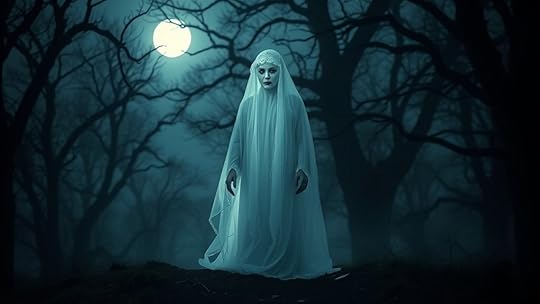
Across many cultures, the haunting image of the White Lady persists as a powerful and mysterious figure. You’ve likely heard stories passed down through generations, woven into historical legends that explain her presence. Whether seen as a tragic victim, a vengeful spirit, or a guardian, her image embodies deep cultural symbolism that resonates with communities worldwide. In these stories, the White Lady often symbolizes themes like loss, longing, or justice, making her a compelling figure that transcends borders and traditions.
The White Lady symbolizes loss, longing, and justice across cultures, embodying timeless themes of tragedy and hope.
You might find that in Western folklore, the White Lady is frequently linked to tragic tales of love and betrayal. In many European legends, she appears as a forlorn bride or a woman who suffered a terrible fate, often mourning her lost love or restless spirit. These stories serve as moral lessons or warnings, rooted in historical legends that have been retold to emphasize the importance of morality or loyalty. Her ghostly presence is seen as an echo of past tragedies, a reminder of the consequences of betrayal or unfulfilled vows. Over time, her image has taken on cultural symbolism as a representation of innocence lost or unresolved grief.
Moving east, you see similar themes but with different cultural nuances. In Asian cultures, legends of spectral women often symbolize spiritual purity or the lingering attachment to loved ones. The White Lady may be viewed as a protective or benevolent spirit, guiding or warning the living. Her appearance in these stories reflects a respect for ancestral spirits and the importance of honoring memory. These legends highlight how cultural symbolism can shape the way a ghostly figure is perceived—sometimes as a warning, sometimes as a protector. The historical legends behind these stories lend them a sense of authenticity and cultural significance, making her a symbol that embodies collective memories and societal values.
Additionally, the cultural symbolism of the White Lady often encompasses themes of justice or retribution, especially in stories where her spirit seeks to right wrongs or deliver warnings to the living. Across these varied traditions, the White Lady’s enduring presence illustrates how collective fears, hopes, and moral lessons are embedded in stories of the supernatural. You see her in haunted castles, remote countryside, and urban legends, always carrying the weight of cultural symbolism rooted in the past. Her ghostly archetype connects histories of tragedy and love, serving as a mirror to human emotions and societal values. Whether as a symbol of mourning, justice, or spiritual protection, the White Lady remains a mesmerizing figure—an enduring emblem of the mysteries that haunt our collective consciousness.
Frequently Asked QuestionsWhat Psychological Factors Contribute to Ghostly Archetypes?You might find that repressed memories and the collective unconscious shape ghostly archetypes in your mind. When you suppress emotions or experiences, your subconscious creates symbols like white ladies to process unresolved feelings. These archetypes tap into shared cultural symbols stored in the collective unconscious, making them feel universal. This psychological process helps you understand and cope with fears, grief, or guilt that surface through ghostly imagery.
How Do Cultural Differences Influence Ghost Stories’ Themes?Cultural differences shape ghost stories’ themes through cultural symbolism and storytelling traditions. You’ll notice that in some cultures, ghostly figures symbolize ancestors or moral lessons, while others focus on spirits of the unrested or vengeful entities. These traditions influence how stories are told, what fears they evoke, and the moral messages they convey. Your understanding of these themes deepens when you consider each culture’s unique symbolism and storytelling style.
Are White Lady Legends Linked to Historical Events?Yes, White Lady legends are often linked to historical events. You see, these stories incorporate historical symbolism, reflecting tragedies or significant moments in local history. Cultural interpretations shape how these legends develop, portraying the White Lady as a ghostly reminder of past injustices or lost loved ones. By understanding these stories, you gain insight into how communities process their history and cultural identity through ghostly archetypes.
How Do Modern Media Portray White Lady Spirits?Modern media portray white lady spirits as mysterious and haunting figures, often blending tradition with contemporary storytelling. In modern cinematic films, they appear as tragic or vengeful spirits, emphasizing emotional backstories. Social media amplifies these legends through viral videos and personal stories, creating a sense of immediacy and realism. You see these portrayals often, making the white lady archetype more accessible, eerie, and relevant to today’s audiences.
Can White Lady Stories Be Explained Through Folklore Psychology?You might see white lady stories as symbolic manifestations rooted in the collective unconscious, reflecting collective fears, desires, or unresolved grief. These tales aren’t just folklore; they tap into universal archetypes that resonate across cultures. By understanding them through folklore psychology, you realize they serve as psychological projections, helping you process complex emotions and societal tensions, making these ghostly figures more than mere legends—they’re echoes of shared human experience.
ConclusionHave you ever wondered why these spectral figures appear so consistently across cultures? The White Lady’s ghostly archetype reminds us that loss, longing, and unresolved stories transcend borders, connecting us through shared fears and hopes. Whether haunting castles or rural roads, these spirits symbolize universal human emotions. So, next time you hear a whisper of a ghostly figure, ask yourself—are they just echoes of our collective memories, or something more mysterious lurking just beyond our understanding?



